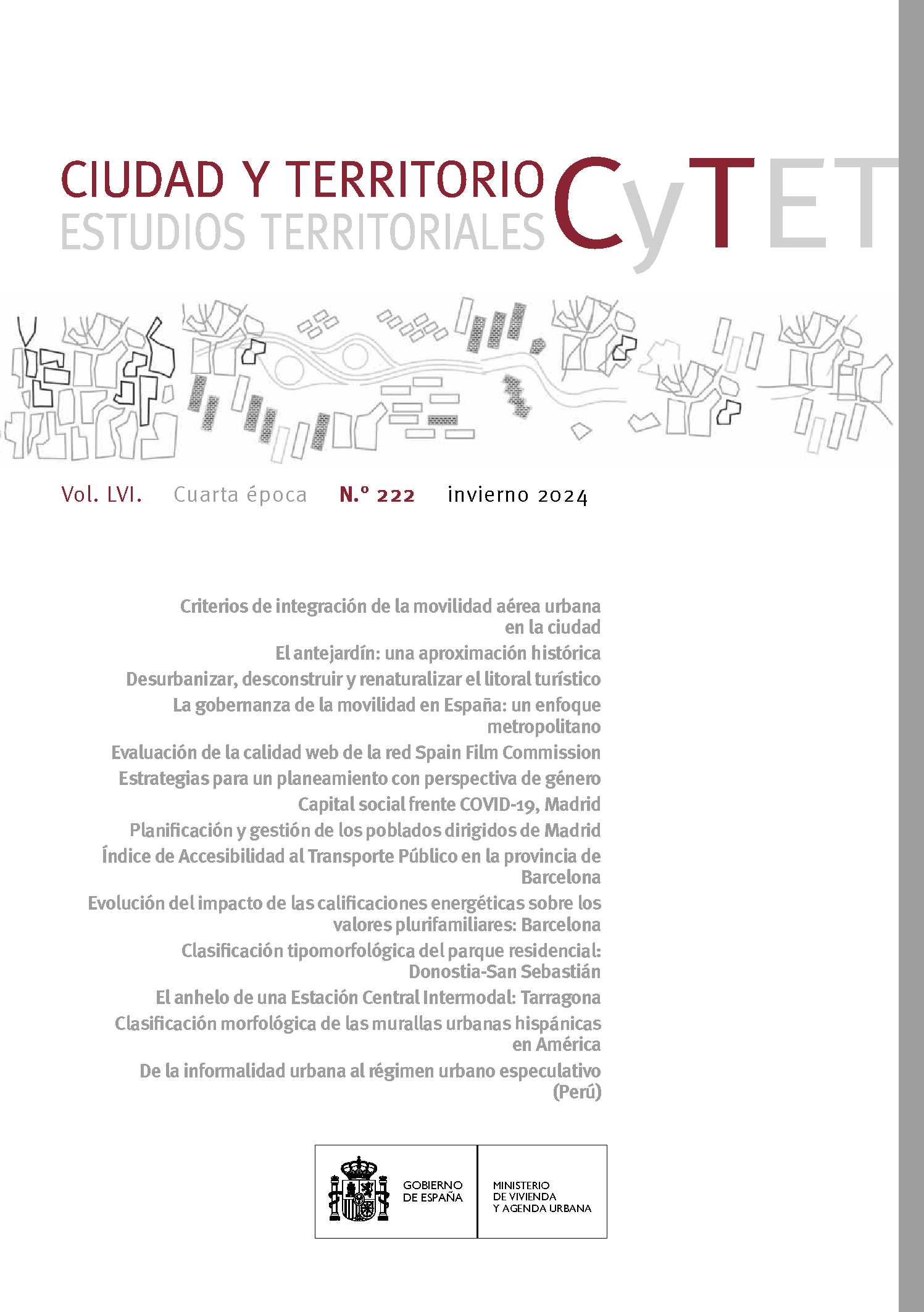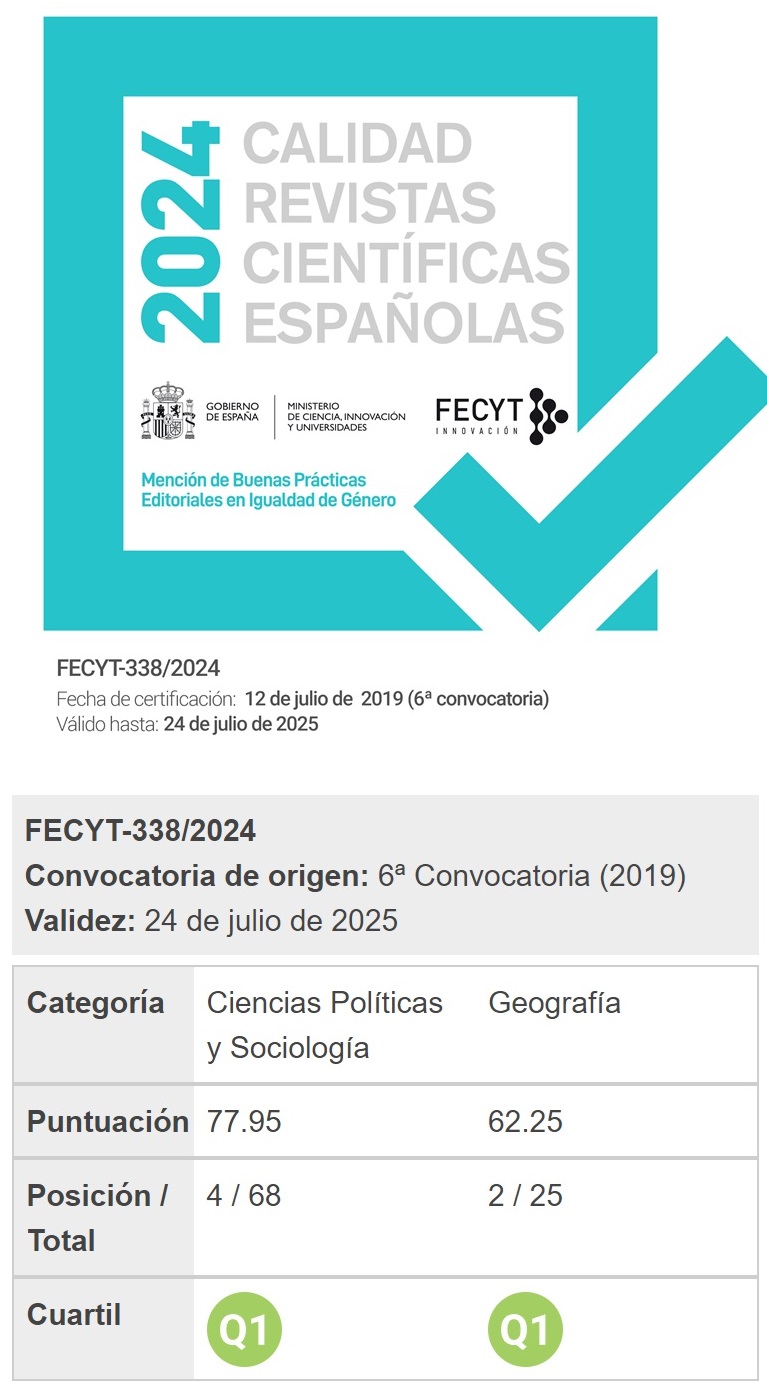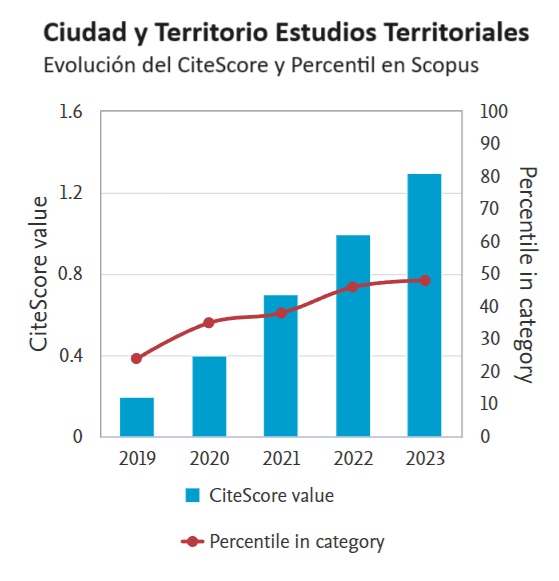Infraestructuras defensivas: clasificación morfológica de las murallas urbanas hispánicas en América
DOI:
https://doi.org/10.37230/CyTET.2024.222.13Palabras clave:
Murallas, Morfología urbana, Hispanoamérica, UrbanismoResumen
Las infraestructuras defensivas más representativas del urbanismo hispánico en América fueron las murallas urbanas, elementos de barrera predominantemente lineales que protegían algunos de estos asentamientos. La presente investigación estudia este tema, con el objetivo de clasificar morfológicamente las murallas urbanas hispánicas en América a partir de su forma en planta. Para ello, se trataron de identificar todos los casos de recintos cercados permanentes realizados por el Imperio Español en América, y se realizó un análisis morfológico, comparativo y tipológico de los casos. Como resultado, se identificaron 18 asentamientos urbanos que contaron con la condición estudiada, clasificando cada uno de los casos entre cuatro tipos básicos. Se diagnosticó que la mayoría de estas murallas tuvieron formas irregulares, muchas veces adaptadas a las características de la geografía. De igual manera, se observó una singular presencia de casos de murallas parciales, que no formaban un recinto cerrado, pero que cumplían eficazmente su función de infraestructura defensiva.
Descargas
Citas
AGUILERA ROJAS, J. (1982): La cuadrícula: un modelo urbano para las ciudades americanas. En Ciudad y Territorio: Estudios Territoriales, (54), pp. 55-80. https://recyt.fecyt.es/index.php/CyTET/article/view/81695
AGUILERA ROJAS, J. (1990): Ciudad abierta y ciudad fortificada. En C. LOPEZOSA APARICIO (dir.), Oro y plata de las Indias en la época de los Austrias, pp. 259-277. Madrid: Fundación ICO.
AGUILERA ROJAS, J. (1994): Fundación de ciudades hispanoamericanas. Madrid: MAPFRE.
ARCOS MARTÍNEZ, N. (2016): Territorio y fortificación del Caribe: Agustín Crame, visitador de plazas 1777-1779. En Biblio3W, Revista Bibliográfica de Geografía y Ciencias Sociales, 21. https://revistes.ub.edu/index.php/b3w/article/view/26325
BLANES MARTÍN, T. (2004): Fortificaciones coloniales del Caribe. Logros, conservación y perspectivas. En Apuntes: Revista de estudios sobre patrimonio cultural, 17, 1-2, pp. 64-75. https://revistas.javeriana.edu.co/index.php/revApuntesArq/article/view/9073
BLANES MARTÍN, T. (2012): La fortificación española en América. De los orígenes a nuestros días. En A. RUIBAL (coord.) (2012). IV Congreso de Castellología. Madrid 7,8 y 9 de marzo de 2012, pp. 201-226, Madrid: Asociación Española de Amigos de los Castillos. https://www.xn--castillosdeespaa-lub.es/es/content/actas-iv-congreso-de-castellologia
CALDERÓN QUIJANO, J. A. (1996): Las fortificaciones españolas en América y Filipinas. Madrid: MAPFRE.
CAPEL, H. (2002): La morfología de las ciudades. I. Sociedad, cultura y paisaje urbano. Barcelona: Serbal.
CHUECA GOITIA, F. (1968): Breve historia del urbanismo. Madrid: Alianza.
COLOMAR ALBÁJAR, M. A. (2019): Construyendo territorio y paisaje: las fuentes. En M. A. COLOMAR ALBÁJAR, y I. SÁNCHEZ DE MORA Y ANDRÉS (coords.), Cuatro siglos de ingeniería española en Ultramar. Siglos XVI-XIX, pp. 16-37. Madrid: Asociación Empresarial de Ingenieros Consultores de Andalucía.
GARCÍA SÁIZ, M. C. (1985): El Pacífico Sur. En J. MAÑAS MARTÍNEZ (dir.), Puertos y fortificaciones en América y Filipinas, pp. 197-212. Madrid: CEHOPU.
GUARDA, G. (1990): Flandes Indiano. Las fortificaciones del Reino de Chile 1541-1826. Santiago de Chile: Ediciones Universidad Católica de Chile.
GUTIÉRREZ, R. (1983): Arquitectura y urbanismo en Iberoamérica. Madrid: Cátedra.
GUTIÉRREZ, R. (2005): Fortificaciones en Iberoamérica. Madrid: Fundación Iberdrola.
GUTIÉRREZ, R. & ESTERAS MARTÍN, C. (1990): América: territorio y fortificación en tiempo de los austrias. En C. LOPEZOSA APARICIO (dir.), Oro y plata de las Indias en la época de los Austrias, pp. 243-254. Madrid: Fundación ICO.
GUTIÉRREZ ESCUDERO, A. (1985): La defensa y las fortificaciones del Caribe español durante la época colonial. En J. MAÑAS MARTÍNEZ (dir.), Puertos y fortificaciones en América y Filipinas, pp. 145-159). Madrid: CEHOPU.
HARDOY, J. E. (1991): Cartografía urbana colonial de América Latina y El Caribe. Buenos Aires: Grupo Editor Latinoamericano.
LLOPIS VERDÚ, J. & PIQUER CASES, J. C. & SERRA LLUCH, J. de (2020): El “Plan de la ciudad de San Agustín de la Florida y sus contornos, situada en la altura septentrional de 29 grados y 50 minutos” de Antonio de Arredondo de 1737. Una ciudad ideal en La Florida Española en el siglo XVIII. En EGA Expresión Gráfica Arquitectónica, 25, 39, pp. 182-195. https://polipapers.upv.es/index.php/EGA/article/view/13953
MALAVE FERNÁNDEZ, R. (2022): Las Plazas Mayores Hispanoamericanas: análisis sistemático, tipológico y morfológico. (2 tomos). Tesis doctoral. La Coruña, España: Universidade da Coruña. http://hdl.handle.net/2183/31556
MAÑAS MARTÍNEZ, J. (dir.) (1985): Puertos y fortificaciones en América y Filipinas. Madrid: CEHOPU.
MENDINUETA, P. (1803): Relación del estado del Nuevo Reino de Granada, presentado por el Excmo. Sr. Virrey D. Pedro Mendinueta a su sucesor el Excmo. Sr. D Antonio Amar y Borbón. Año de 1803. En E. POSADA y P. M. IBÁÑEZ (1910). Relaciones de mando. Memorias presentadas por los gobernantes del Nuevo Reino de Granada, compiladas y publicadas por E. Posada y P. M. Ibáñez, pp. 411-588. Bogotá: Imprenta Nacional.
MUÑOZ ESPEJO, F. M. (2004): La valoración universal de la fortificación y las fortificaciones virreinales en México. En Apuntes: Revista de estudios sobre patrimonio cultural, 17, 1-2, pp. 76-89. https://revistas.javeriana.edu.co/index.php/revApuntesArq/article/view/9074
PALADINI CUADRADO, A. (1989): Cartografía militar española de Indias. En Militaria: Revista de Cultura Militar, 1, pp. 57-90. https://revistas.ucm.es/index.php/MILT/article/view/MILT8989110057A/3510
PÉREZ HERRERO, P. & VIVES AZANCOT, P. A. (1985): Puertos, fortificaciones y defensa de las Indias a través del Virreinato Novohispano. En J. MAÑAS MARTÍNEZ (dir.), Puertos y fortificaciones en América y Filipinas, pp. 161-180. Madrid: CEHOPU.
RAMOS ZÚÑIGA, A. (1993): La fortificación española en Cuba, siglos XVI-XIX. En ATRIO, 5, pp. 49-64. https://www.upo.es/revistas/index.php/atrio/article/view/3330
REDONDO GÓMEZ, M. (2004): Cartagena de Indias. Cinco Siglos de Evolución Urbanística. Bogotá: Universidad de Bogotá Jorge Tadeo Lozano.
SETA, C. de & LE GOFF, J. (coords.) (1991): La ciudad y las murallas. Madrid: Cátedra.
SOLANO, S. P. (2013): Sistema de defensa, artesanado y sociedad en el Nuevo Reino de Granada. El caso de Cartagena de Indias, 1750-1810. En Memorias: Revista Digital de Historia y Arqueología desde el Caribe Colombiano, 19, pp. 92-139. https://hdl.handle.net/11227/396
TERÁN, F. de (coord.) (1989): El sueño de un orden. La ciudad hispanoamericana. Madrid: CEHOPU.
VÉJAR PÉREZ-RUBIO, C. (2014): San Francisco de Campeche entre flotas y murallas. En Archipielago. Revista Cultural de Nuestra America, 21, 84, pp. 60-62. https://www.revistas.unam.mx/index.php/archipielago/article/view/55636/49352
VIVES AZANCOT, P. A. (1985a): Tres siglos de fortificación e infraestructura portuaria en la América Española. En J. MAÑAS MARTÍNEZ (dir.), Puertos y fortificaciones en América y Filipinas, pp. 45-59. Madrid: CEHOPU.
VIVES AZANCOT, P. A. (1985b): La fachada Sud-Atlántica de América. Siglos XVI a XVIII. En J. MAÑAS MARTÍNEZ (dir.), Puertos y fortificaciones en América y Filipinas, pp. 181-195. Madrid: CEHOPU.
ZAPATERO, J. M. (1976): La plaza fortificada de Panamá. En Ibero-amerikanisches Archiv, 2, 3, pp. 227-256.
ZAPATERO, J. M. (1985): La escuela de fortificación hispanoamericana. En J. MAÑAS MARTÍNEZ (dir.), Puertos y fortificaciones en América y Filipinas, pp. 63-71. Madrid: CEHOPU.
ZAPATERO, J. M. (1989a): Las llaves fortificadas de la América Hispana. En Militaria. Revista de Cultura Militar, 1, pp. 131-140. https://revistas.ucm.es/index.php/MILT/article/view/MILT8989110131A
ZAPATERO, J. M. (1989b): Las fortificaciones históricas de San Juan de Puerto Rico. En Militaria. Revista de Cultura Militar, 1, pp. 141-175. https://revistas.ucm.es/index.php/MILT/article/view/MILT8989110141A
Publicado
Cómo citar
Número
Sección
Licencia
Derechos de autor 2024 Rafael Malave Fernández, Óscar Aceves Álvarez, Valentina Caradonna Caimi

Esta obra está bajo una licencia internacional Creative Commons Atribución-NoComercial-SinDerivadas 4.0.
Sin perjuicio de lo dispuesto en la legislación vigente sobre Propiedad Intelectual, y conforme a la misma, el/la los/las autor/a/es/as que publiquen en CyTET cede/n a título gratuito, de modo no exclusivo y sin límite temporal al Ministerio de Transportes, Movilidad y Agenda Urbana los derechos para difundir, reproducir, comunicar y distribuir en cualquier formato actual o futuro, en papel o electrónico, la versión original o derivada de su obra bajo licencia de Creative Commons Reconocimiento-NoComercial-SinObraDerivada 4.0 Internacional (CC BY-NC-ND 4.0), así como para incluir o ceder a terceros la inclusión de su contenido en índices, repositorios y bases de datos nacionales e internacionales, con referencia y reconocimiento en todo caso de la autoría del mismo.
Además, al realizar el envío, el/la los/las autor/a/es/as declara/n que se trata de un trabajo original en el que se reconocen las fuentes que han sido utilizadas en su estudio, comprometiéndose a respetar la evidencia científica y a no modificar los datos originales para verificar o refutar una hipótesis de partida; que el contenido esencial del mismo no ha sido publicado previamente ni se publicará en ninguna otra obra o revista mientras esté en proceso de evaluación en la revista CyTET; y que no se ha remitido simultáneamente a otra publicación.
Los autores deben firmar un Formulario de Cesión de Derechos, que les será enviado desde la Secretaría de CyTET una vez se acepte su artículo para ser publicado.
Con el objetivo de favorecer la difusión del conocimiento, CyTET se adhiere al movimiento de revistas de Open Access (OA) y entrega la totalidad de sus contenidos a diversos índices, repositorios y bases de datos nacionales e internacionales bajo este protocolo; por tanto, la remisión de un trabajo para ser publicado en la revista presupone la aceptación explícita por parte del autor/a de este método de distribución.
Se anima a las/os autoras/es a reproducir y alojar sus trabajos publicados en CyTET en repositorios institucionales, páginas web, etc. con la intención de contribuir a la mejora de la transferencia del conocimiento y de la citación de dichos trabajos.








 Enlace a CyTET en Linkedin
Enlace a CyTET en Linkedin